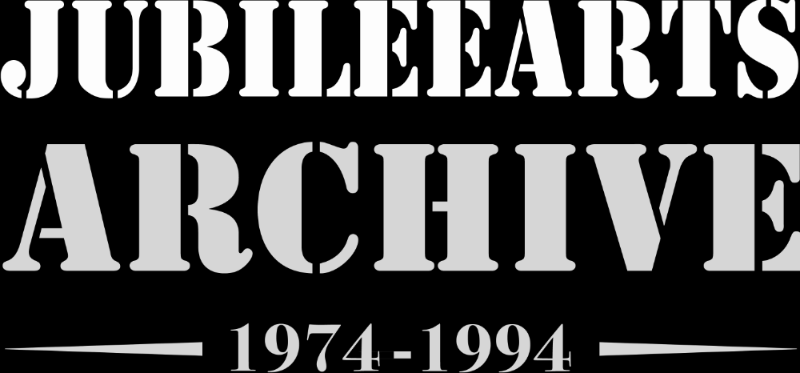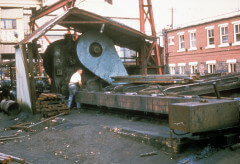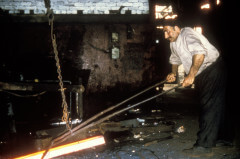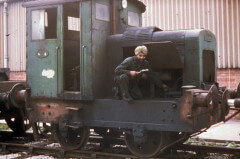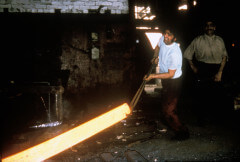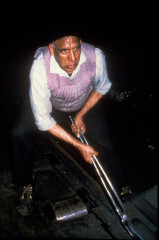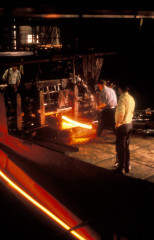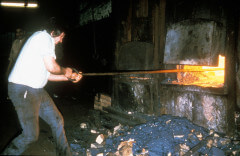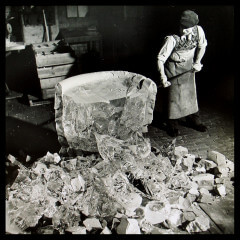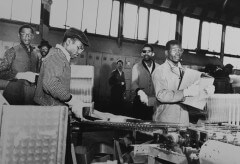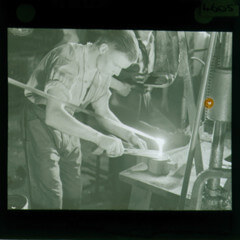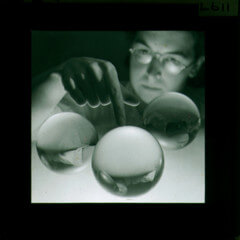The Black Country, once a landscape of furnaces, foundries and fire.
When we speak of the Black Country, we hear of fierce loyalty to the specific locality, the street, the housing estate, the village of birth. Two hundred years ago there was little here except heathland, a few settlements, the ruined castle on an outcrop of limestone at Dudley, a toll road running through West Bromwich to Shrewsbury and onto Holyhead. The coming of the Industrial Revolution irrevocably changed the landscape and the people, the geology of the area providing all the necessary ingredients for mass production. Iron and coal, brass and boilers, guns and glass, chains and tubes, later steel and chemicals. As James Watt opened his revolutionary Soho Foundry in Smethwick in 1796, Brindley and Telford cut the canals to move the industrial goods. As people migrated here to work in the new factories, the population of the area exploded. By the 1840s, a third of all workers in England and Wales were involved with industrial production.
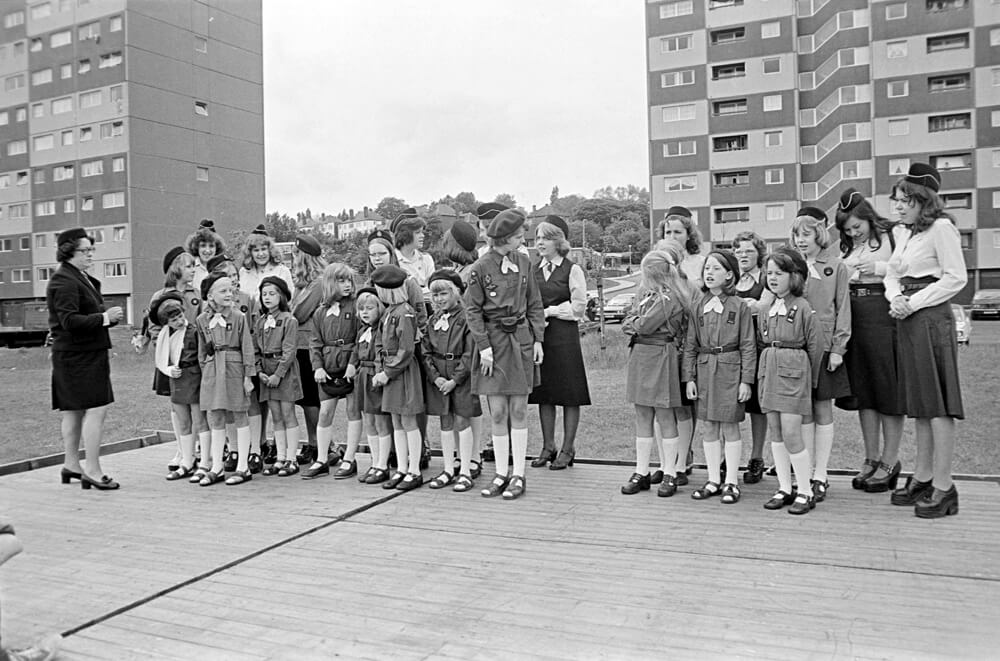
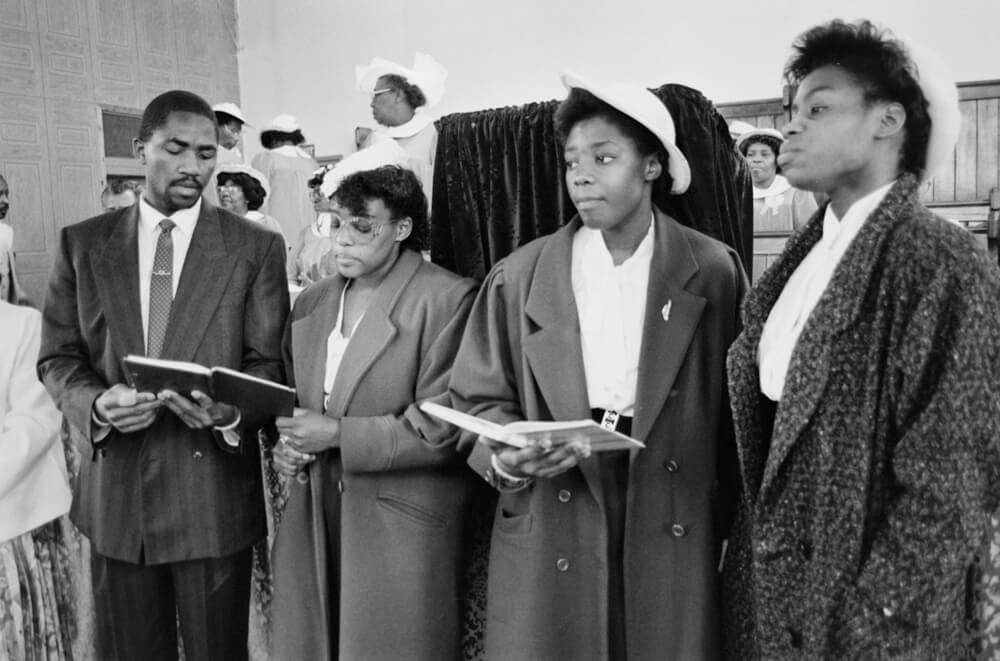
Where exactly is the Black Country?
“Doubtless a majority of our English readers have passed through this remarkable district once in their lives, and remember its most striking features.”
Elihu Burritt, Walks in the Black Country, 1868
Here exists a place where people can’t agree where it geographically begins or ends, where the boundaries are ill-defined and permeable and apparently moveable. Traditionalists might tell you that the Black Country is the area where the coal seam comes to the surface – so encompassing West Bromwich, Oldbury, Blackheath, Cradley Heath, Old Hill, Bilston, Dudley, Tipton, Wednesfield and parts of Halesowen, Wednesbury and Walsall – but apparently not Wolverhampton, Stourbridge and Smethwick or what used to be known as Warley.
Alton Douglas said it was easier to tie a jelly with a string than define the Black Country and Dr Chris Upton reminds us that it is often said that the easiest way to start a fight in a Black Country pub is to ask for a definition of the term.
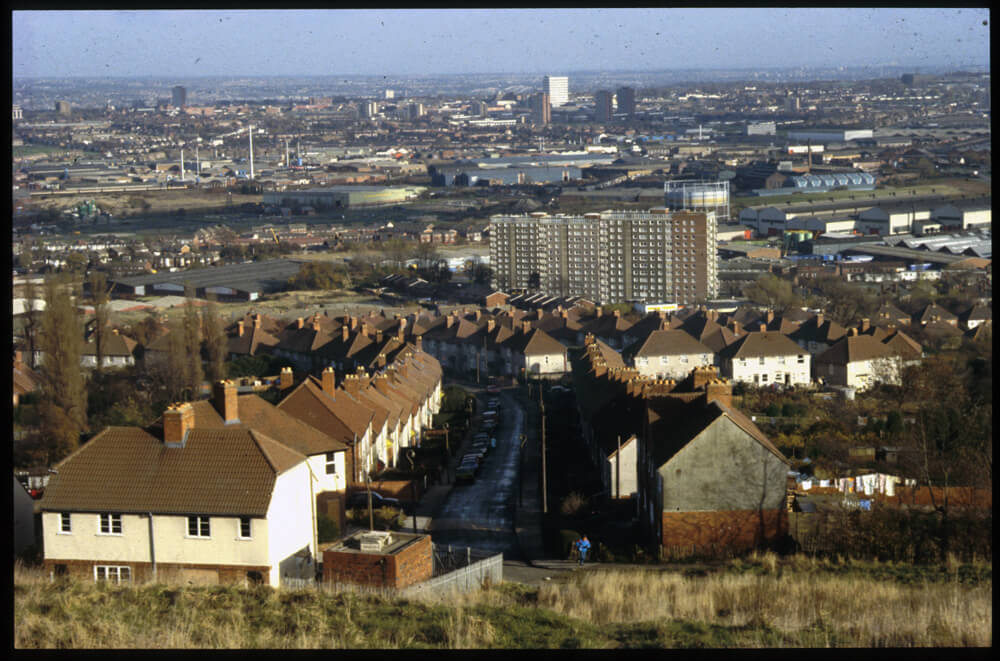
The geographical limits have been differently located by Elihu Burritt (1868), S.H. Beaver (1945) and Walter Allen (1946), but today the Black Country region is associated with the modern metropolitan boroughs of Sandwell, Walsall, Dudley and Wolverhampton, most of which were formerly part of North Worcestershire and South Staffordshire. Dominated by a range of hills and surrounded by green space, it was the geology of the area which determined its industrial development. The Black Country contained Europe’s thickest coal seam, the ‘Thirty Foot Seam’ close to the surface and thus easily mined. Other resources included iron ore for furnaces, limestone which was used as a flux to remove impurities in the process of smelting iron, sand for cast-iron mouldings, Etruria Marl, a clay for brick-making, sandstone for building and Rowley Rag for road construction.
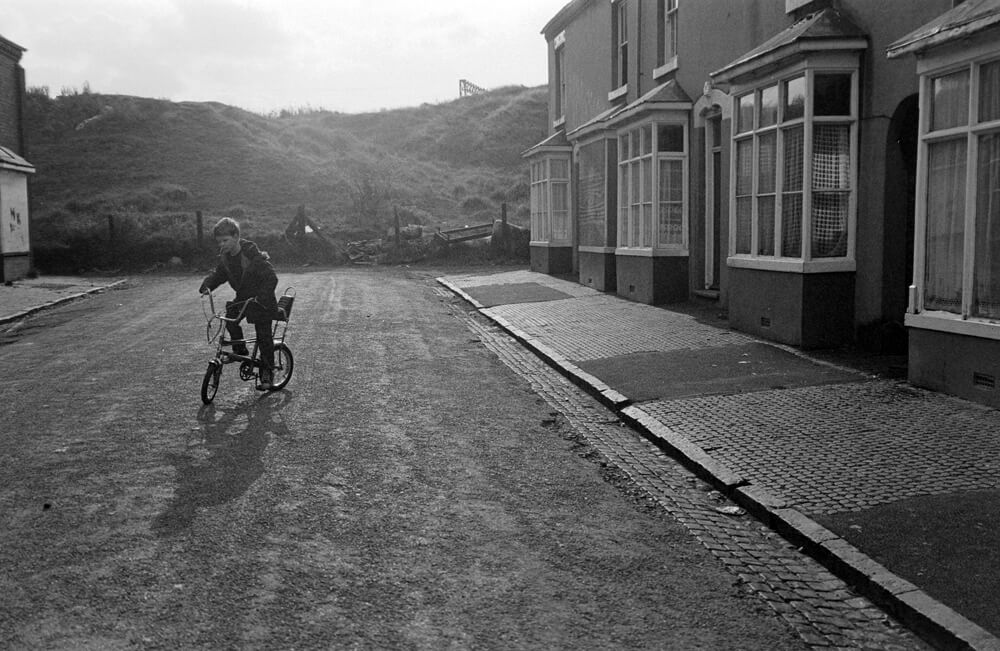
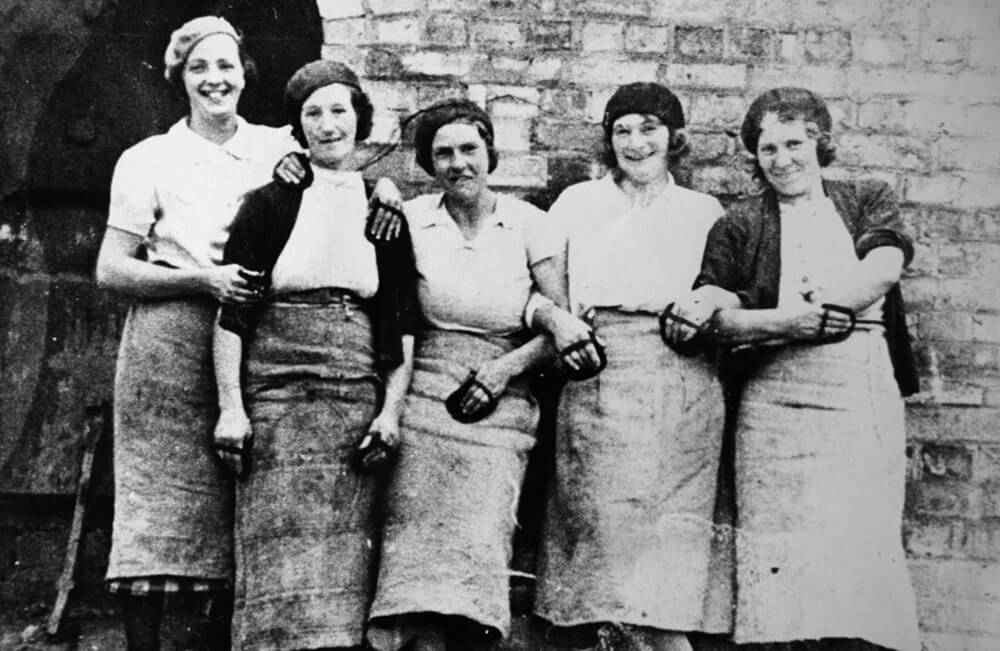
Contributing to a long debate on a BBC web forum on the subject we find ‘Neil’ provides us with this comprehensive summary:
“Industrialisation in the Black Country goes far back. It was already an area where metal working was important as far back as the 16th century, due to the presence of iron ore and of coal in a seam 30 feet (about 9 metres) thick, the thickest seam in Great Britain, which outcropped in various places. Many people had an agricultural smallholding and supplemented their income by working as nailers or smiths, an example of a phenomenon known to economic historians as proto-industrialisation. By the 19th century or early 20th century, many villages had their characteristic manufacture, but earlier occupations were less concentrated. Some of these concentrations are less ancient than sometimes supposed. For example, chain making in Cradley Heath seems only to have begun in about the 1820s, and the Lye holloware industry is even more recent.
Prior to the Industrial Revolution, coal and limestone were worked only on a modest scale for local consumption, but during the Industrial Revolution by the opening of canals, such as the Birmingham Canal Navigations, Stourbridge Canal and the Dudley Canal (the Dudley Canal Line No 1 and the Dudley Tunnel) opened up the mineral wealth of the area to exploitation. Advances in the use of coke for the production in iron enabled iron production (hitherto limited by the supply of charcoal to expand rapidly. By Victorian times, the Black Country was one of the most heavily industrialised areas in Britain, and it became known for its pollution, particularly from iron and coal industries and their many associated smaller businesses. The area soon gained notoriety. Charles Dickens’s novel The Old Curiosity Shop, written in 1841, described how the area’s local factory chimneys “Poured out their plague of smoke, obscured the light, and made foul the melancholy air”. In 1862, Elihu Burritt, the American Consul to Birmingham, described the region as “black by day and red by night”, because of the smoke and grime generated by the intense manufacturing activity. The area is popularly said to have got its name because of pollution from these heavy industries, which covered the area in black soot and led to the name of The Black Country.
There is a famous but dubious anecdote about Queen Victoria ordering the blinds lowered on her carriage as the royal train passed through the area. However, historians have suggested that it is more likely that the name was given earlier, arising from above-ground outcroppings of black coal seams that scarred the early heathland. Also, the coal seam just below the surface meant the soil in the area was very black. It is said that J.R.R. Tolkien based the grim region of Mordor on the heavily industrialized Black Country area in his famed novel The Lord of the Rings. Indeed, in the Elvish Sindarin language, Mor-Dor means Dark (or Black) Land, and is sometimes even referred to within the novel as ‘The Black Country’.”
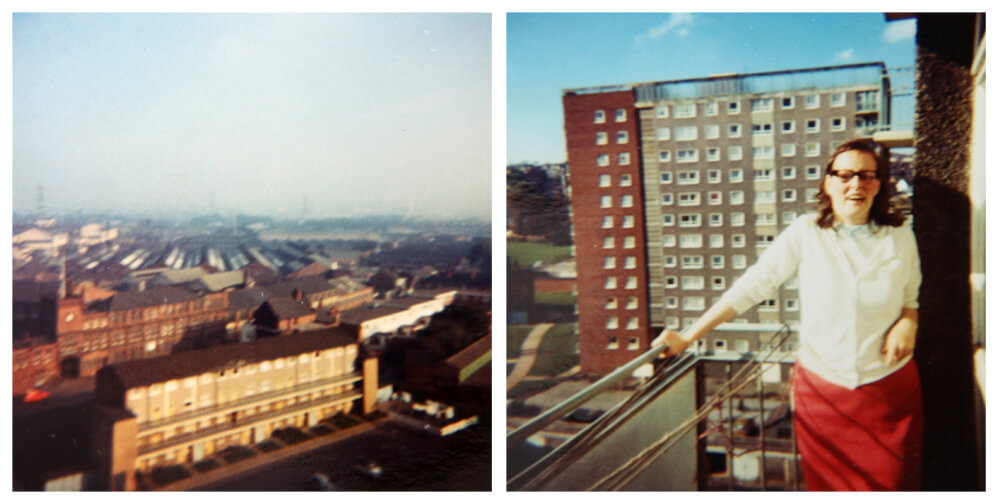
The rocky ridge stretched from Turner’s Hill, Rowley Regis along Dudley Castle Hill and Wren’s Nest to Sedgley Beacon provided a viewing platform for observers of the area’s industrial activity. In 1830 the young James Nasmyth (1808-1890), the inventor of the steam hammer, recorded his impressions from Dudley Castle:
‘Melancholy grandeur is rendered all the more impressive by the coal and iron works with which it is surrounded…The venerable trees struggle for existence under the destroying influence of sulphuric acid; while the grass is withered and the vegetation everywhere blighted. I sat down on an elevated part of the ruins, and looked down upon the extensive district, with its roaring and blazing furnaces, the smoke of which blackened the country as far as the eye could reach; and as I watched the decaying trees I thought of the price we had to pay for our vaunted supremacy in the manufacture of iron.’
He had just finished a long walk to the Black Country from Coalbrookdale to Dudley. His conclusion was anything but flattering.
The Black Country is anything but picturesque. The earth seems to have been turned inside out. Its entrails are strewn about; nearly the entire surface of the ground is covered with cinder heaps and mounds of scoriae. The coal which has been drawn from below ground is blazing on the surface. The district is crowded with iron furnaces, puddling furnaces, and coal-pit engine furnaces. By day and by night the country is glowing with fire, and the smoke of the ironworks hovers over it. There is a rumbling and clanking of iron forges and rolling mills. Workmen covered with smut, and with fierce white eyes, are seen moving about amongst the glowing iron and the dull thud of forge-hammers.
Amidst these flaming, smoky, clanging works, I beheld the remains of what had once been happy farmhouses, now ruined and deserted. The ground underneath them had sunk by the working out of the coal, and they were falling to pieces. They had in former times been surrounded by clumps of trees; but only the skeletons of them remained, dead, black, and leafless. The grass had been parched and killed by the vapours of sulphurous acid thrown out by the chimneys; and every herbaceous object was of a ghastly gray – the emblem of vegetable death in its saddest aspect… In some places I heard a sort of chirruping sound, as of some forlorn bird haunting the ruins of the old farmsteads. But no! The chirrup was a vile delusion. It proceeded from the shrill creaking of the coal-winding chains, which were placed in small tunnels beneath the hedgeless road.
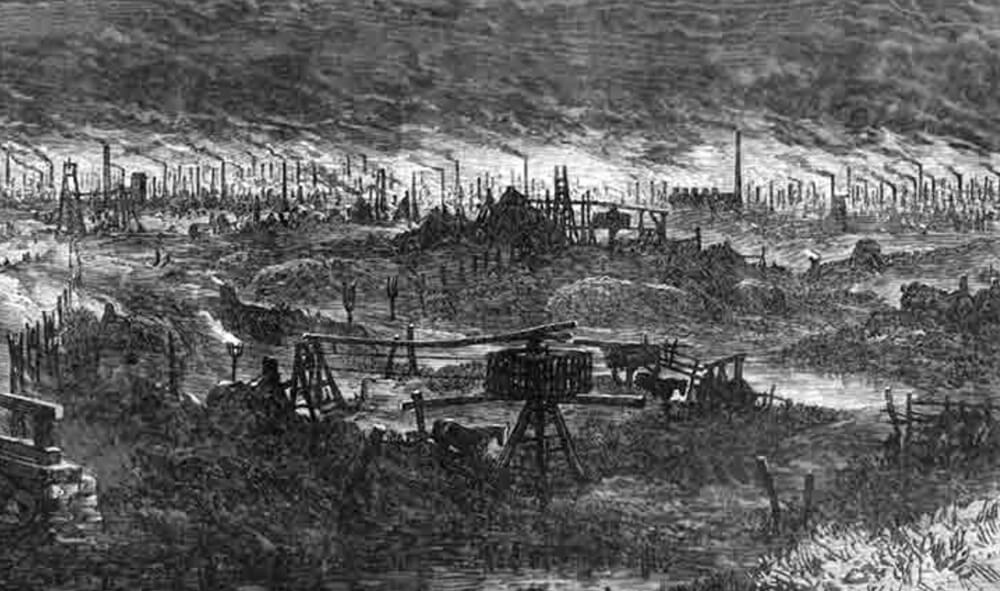
This image from the Illustrated London News (December 1866), illustrates the written impressions provided by a stream of 19th century writers. The background presents a landscape packed with industrial activity and pollution from steam-powered chimneys. In the foreground relics of desolation and older activity remain, including a horse gin which had been used to draw coal out of a mine.
This ancient industrial landscape had begun to disappear with the closure of old factories and foundries. As Black Country archaeologist Paul Quigley puts it: “Iron smelting had taken place in hundreds of blast furnaces in the area since the 1700s but the last one, at Bilston, was demolished at the end of the 1970s. The heir to 200 years of iron making has now disappeared under a Poundland depot. Indeed, we might say that while Leicester has found a king buried under a car park, we have Elizabeth, last queen of the Black Country blast furnaces, interred under a discount superstore.” Yet still there is a tradition of ‘metal-bashing’ in the area, with more than a third of manufacturing employment still working in these categories. Sandwell had, until recently, the highest concentration of council housing (and tower blocks) in the country.
After the Second World War, new migrants came to the area from the countries of the Commonwealth, bringing new diversity, cultures and languages; mostly from the islands of the Caribbean, from India, Pakistan and Yemen. The first Gurdwara in the country was on the High Street in Smethwick. A former Congregational Chapel building, the temple was opened by Sikh community in 1961. It now has one of the largest congregations in the UK. And down the road in Oldbury is the Shri Venkateswara (Balaji) Temple set in a approximately 30 acres of reclaimed land, the largest Hindu temple of its kind in Europe.

About the local dialect
Some years ago, university researchers came from Norway to study the local dialect, believing it to be close to Old Norse. (It is not to be compared with a Brummie accent.) Others claim it close to the Old English, the language of Chaucer, but local dialect is disappearing in the district.
In the Forties, Fifties and Sixties, “thou, she, you, hers. Theirs, whose, am, and are” were never heard out of school, but in place of them were heard “thee, her, yo, hern, hisn, theyrn, whosen, and bin”, the last named doing duty for and are. It was always “her was this, her said that, and her did t’other. If anyone said “she” companions would stare with as much wonder as though the speaker was a foreigner.
The most peculiar sentences were those asking questions. “Bist and bisnt, wast and wasn’t, hast and hasn’t, cost and cosnt, shost and shosna, wust and wusnt”.
An article on Black Country dialect can be downloaded here, written by Brendan Jackson for a project called ‘Where’s Our Spake Gone’
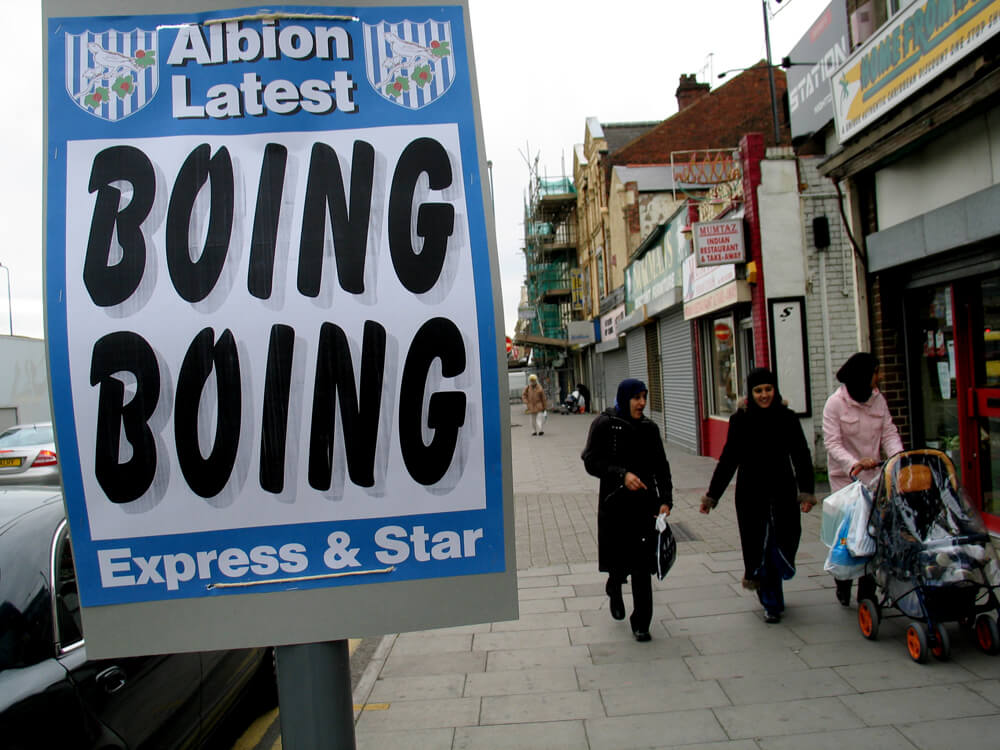
The following are sample phases:
“How dew?
How bist?
How bist thee? (accent on thee),
How bin yer? (accent on bin),
How bin yo? (accent on yo),
Bist gooin?
Bay yo gooin?
No I bay, bist thee?
Why wusn’t let her goo?
Cos I wo.”
Steve Melia was a member of the management committee of Jubilee Arts. Today he serves as a Sandwell councillor. With a keen interest in local history and culture, he regularly makes presentations about Black Country dialect, and this is an extract from a talk he did at West Bromwich library
Barry Matthews first came to the Black Country in the 1970s. As an accountant he worked with many factories locally. He was closely involved with the establishment of the innovative Arts Lab in Birmingham, and later did the accounts for a number of local arts organisations and freelance artists, including Jubilee. Here he reflects on his first impressions of the area.
